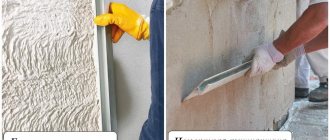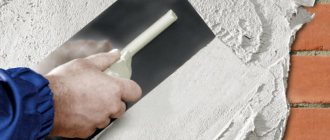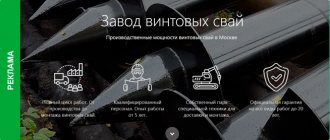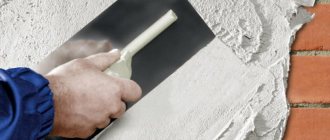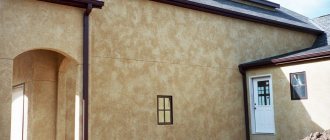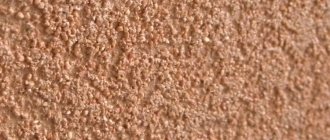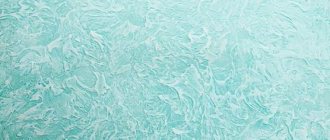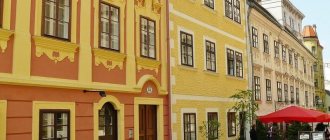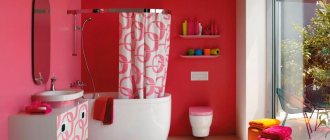05/10/2018 Gypsum plaster is a common finishing material used for repairs and furnishing of rooms with normal humidity. Today the construction market offers a wide range of such products. This allows you to select the appropriate option based on the requirements: place of application (ceiling, walls, inside, outside), application technology, consumption, type of subsequent finishing, color, packaging, technical characteristics, price, etc. Before purchasing, we recommend that you find out what differences between gypsum plasters should be taken into account, how to choose the material correctly and according to what parameters.
Components of cement plasters
The main and mandatory materials are sand and cement. The standard ratio by volume is 3 to 1. These materials are mixed dry and thoroughly mixed with the addition of water. By adjusting the amount of water, the required concentration of the solution is achieved.
However, such cement-sand plaster has a drawback - low adhesion to concrete surfaces. This problem can be solved by adding milk of lime to the mixture (1 part by volume). This produces lime-cement plaster.
Using additional components you can change:
- plastic,
- heat resistance,
- viscosity
and other properties of cement plaster.
Cement is a hydraulic binder that gains strength as a result of mixing with water and its further evaporation. Further exposure of the plaster layer to water does not lead to a deterioration in its characteristics.
High resistance to external influences allows the use of cement-based plaster for treating interior and exterior surfaces of construction projects.
What is this article about?
Plaster refers to two groups of fundamentally different building materials. Firstly, plaster is a leveling, strengthening mixture intended for rough work. Secondly, finishing solutions for decorative finishing.
Basic alignment of the geometry of the room is carried out using mineral plasters with a base of cement or gypsum. Decorative decoration of walls - with expensive acrylic, silicate, silicone solutions, as well as more budget thin-layer cement mixtures such as “Bark Beetle”, “Shuba”, etc.
Naturally, materials with such different tasks should not be combined into one category, since this can only confuse, and our goal is to help you understand. Therefore, today we will talk exclusively about “rough” plaster.
Components of gypsum plasters
The main and mandatory is gypsum. Also added to it:
- lightweight fillers (reduce plaster consumption by weight per square meter),
- modifying additives (strengthen adhesion to the material of the surface being treated).
Gypsum is an air binder, which, having hardened after the water evaporates, remains solid only in air. Moisture entering a gypsum plastered surface leads to destruction of its structure. Therefore, gypsum plaster is used only for finishing interiors with normal or low humidity.
General information data
All gypsum plaster mixtures have basic general technical characteristics. But it should still be borne in mind that the numbers may differ based on the constituent ingredients and the manufacturer of the material.
| Operating air temperature | 5-30°С |
| Maximum thickness of coating layers | 5 cm |
| Solution dilution ratio: dry mixture to water | 2 : 1 |
| Consumption amount of finished mass | 8 kg/sq.m |
| The material is setting | in 60 minutes |
| The coating dries completely | at least 3 hours |
| Surface strength | recruited in 7 days |
Now the market offers gypsum finishing material of various brands. The most popular of them are: Volma, Prospectors, Knauf rotband, Hercules Rotger, Forman, Teplon, Rotgips. Let's take a closer look at each version of the plaster mixture of these brands. 1. Volma gypsum plaster layer has the following technical characteristics:
- Available in packages of 5, 15, 25 and 30 kg;
- used indoors with minimal temperature difference;
- not resistant to moisture. The humidity level in the room should be within normal limits;
- used for plastering wall planes, rarely ceilings;
- unsuitable for floors because it has a large load;
- easy to apply, plastic;
- does not shrink, due to this it can be applied immediately in one layer (but no more than 6 cm in thickness);
- does not require preliminary or finishing putty work. After drying, the coating becomes glossy.
2. Prospector gypsum plaster and its technical characteristics:
- Available in 30 kg packages;
- has two color options: white and gray;
- used in rooms where humidity is moderate;
- bonds well to different substrates: brick, concrete, foam block, gas block, wood, OSB sheet, etc.;
- does not crack during operation;
- has high heat and sound insulation properties;
- sets and dries quickly;
- It is plastic, due to this it is easily distributed over the plane without forming lumps.
3. Technical characteristics of Knauf Rotband gypsum plaster:
Rotband - gypsum plaster, 30kg
- perfectly connects to brick, concrete and foam bases;
- used for plastering walls and ceilings;
- suitable for use in the bathroom and kitchen;
- the minimum operating temperature in the building when applying the composition is 5°C;
- the thickness of one applied layer is not less than 5 mm;
- Complete drying of the coating is achieved after 7 days.
4. Technical characteristics of Hercules gypsum plaster:
- used for leveling wall and floor planes;
- does not require subsequent putty;
- thickness of one applied layer – no more than 30 mm;
- economical to use;
- tolerates normal room humidity well, can be used when finishing kitchen wall surfaces;
- it is convenient to apply and spreads well over the surface, does not creep or form a lump;
- adheres firmly to various substrates;
- When dry, it becomes a durable coating.
5. Technical characteristics of Forman gypsum plaster:
Forman No. 10 gypsum plaster, 25 kg
- used for finishing brick surfaces, as well as walls made of any other materials inside the building;
- does not require additional putty work;
- adheres firmly to various substrates;
- has a high degree of plasticity;
- Available as white powder in packages of 5, 25 and 30 kg;
- the thickness of one applied layer is 5-50 mm.
6. Technical characteristics of Teplon gypsum plaster:
- Available in white;
- the presence of an additional component of perlite in the composition reduces the drying period of the solution on the surface;
- has a high degree of thermal insulation and strength;
- does not require finishing with putty;
- suitable for interior and exterior work;
- firmly adheres to wooden bases, brick and concrete.
7. Technical characteristics of gypsum plaster Rotgips:
- release form: white powder, packed in paper bags, packed in 30 kg packs;
- used for leveling wall and ceiling surfaces;
- firmly adheres to various substrates made of concrete or brick, as well as plastered surfaces;
- works well in rooms with normal humidity;
- does not cause allergies, does not emit toxic substances;
- plastic and durable;
- has little consumption during application.
Number and thickness of layers
To achieve the required quality of the surface of the plastered layer when using cement plaster, it is necessary to sequentially apply at least 2 layers (the thickness of each layer without reinforcement is no more than 2 cm, and when using hardeners - up to 6 cm). For gypsum plaster, in most cases, one layer is sufficient, which can be up to 6 cm thick.
Taking into account all these characteristics when searching for a material for surface treatment allows you to make the most rational choice!
Preparing walls for plastering
Before rough finishing of walls with gypsum compounds, the following steps must be taken:
- Remove the old coating and clean the surface from grease stains, dust, wallpaper and paint residues.
- Tap the surface with a hammer to identify weak fragments of the wall and remove them.
- Seal cracks, potholes and chips with polyurethane foam or cement mortar.
- Prime the walls twice with an interval of 4 hours.
Stages of surface preparation for applying gypsum plaster
Important! When the thickness of the applied gypsum mixture is large, it tends to fall off quickly, so installation of a reinforcing mesh is required.
Mesh installation:
- First of all, markings are applied to the wall - dots every 40 cm.
- Drill holes in the marked places and install dowels.
- Using metal scissors, cut the mesh into fragments of the required area and shape.
- Place the product against the wall and secure it with self-tapping screws.
Installation of reinforcing mesh is necessary when applying a large layer of plaster.
If the mesh is not installed tightly or vibrates when touched, it is necessary to additionally strengthen it with wire, threading it through the cells in the shape of the letter Z.
Density of lightweight concrete
Lightweight concrete has a density of 500 kg/m3. This parameter is characteristic of expanded clay, cellular, perlite and polystyrene concrete. This material is reinforced with reinforcement. The average density of reinforced concrete depends not only on the composition, but also on the pouring method. If the liquid mixture is compacted using vibration machines, the density will increase by 100 kg/m3.
Advantages and disadvantages of gypsum-based plaster solutions
Let's look at the pros and cons of gypsum plaster. The advantages include:
- high speed of application and drying;
- good elasticity of the mixture;
- versatility (can work on different types of surfaces);
- possibility of one-stage plastering;
- excellent quality of the result;
- vapor permeability properties;
- antiseptic qualities;
- Requires a minimum of finishing putty.
Minuses:
- low strength;
- low resistance to moisture;
- does not tolerate sudden temperature changes.
How to dry?
The surface should dry under natural conditions. There should be no drafts or operating heating devices in the room; the required air temperature should not be lower than +5 and not higher than +25°C. Direct sunlight on the coating is not allowed. Do not speed up drying with a heat gun or any other heating equipment.
After 3-7 days, the room must be thoroughly ventilated to remove moisture from the plaster layer. The plaster will dry completely and gain strength only after 1-2 weeks. The finished surface should be smooth and light. Then you can glue tiles or wallpaper onto it. And the moisture content of the coating for painting should not exceed 1%.
Sand selection
What kind of sand will be in the solution determines the quality of the entire coating and therefore this factor cannot be neglected. Interestingly, not all craftsmen agree on the sand component. For some, the best material is sea sand, while others prefer river sand, as it has a fairly uniform grain shape. The absence of impurities ensures the use of a high-quality mixture with a high level of adhesion.
In order not to bother with the choice of sand, it is better to give preference to ready-made mixtures that already contain all the components in the correct and proven proportions. By and large, you can take both sea and river sand. The basic rule for preparing a cement-sand mixture that is ideal for plastering is the purity of the material; it should not contain impurities, dirt or organic particles.
We carry out calculations
Calculating wall thickness based on thermal conductivity is an important factor in construction. When designing buildings, the architect calculates the thickness of the walls, but this costs extra money. To save money, you can figure out how to calculate the necessary indicators yourself.
The rate of heat transfer by a material depends on the components included in its composition. The heat transfer resistance must be greater than the minimum value specified in the regulatory document “Thermal insulation of buildings”.
Let's look at how to calculate the thickness of a wall depending on the materials used in construction.
δ is the thickness of the material used to build the wall;
λ is an indicator of specific thermal conductivity, calculated in (m2 °C/W).
When you purchase building materials, the thermal conductivity coefficient must be indicated in the passport.
Application area
Knauf mixtures are suitable for all types of finishing work. In the line of this manufacturer you will find ready-made mixtures for work both on internal and external walls, in buildings with low or high humidity, for old walls cracked from years of testing, both manually and machine-applied Rotband gypsum plasters. They are ideally combined with concrete, brick, foam plastic, fiberboard, as well as with already applied mixture! Rotband gypsum plasters are widely used in kitchens and bathrooms. Ideally connected to cleaned concrete walls and ceilings.
Applying the solution in case of strong changes
Differences exceeding 5 cm require applying the solution in several layers, separated from each other by a reinforcing mesh. It facilitates the adhesion of the solution to the surface, gives it additional strength, and prevents shrinkage and cracking. Beacons are not always used in this case.
You will need to make notches on the first layer of plaster and apply the second layer only after the first has dried.
When plastering monolithic walls, they need to be sprayed a little to increase the degree of adhesion.
